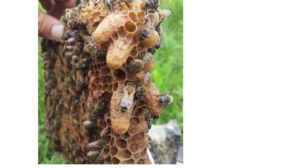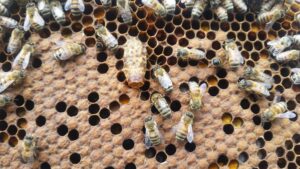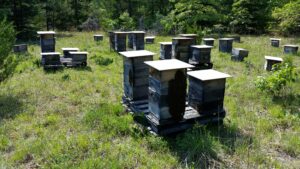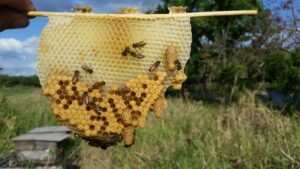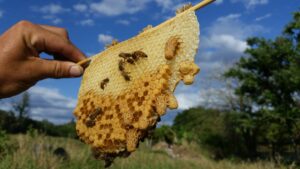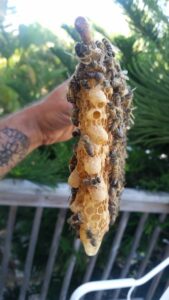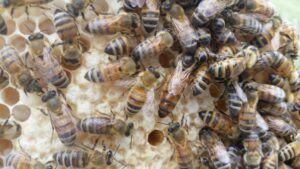Final report for FNE20-964
Project Information
Beekeepers have faced unprecedented challenges since the introduction of the Varroa destructor mite and the viruses it vectors. While worldwide breeding efforts have mostly failed, a grassroots “Darwinian” approach could bring about resistance on localized levels (Guichard, et al 2020). But many beekeepers believe they do not have the time, the skill, or the bee resources to raise quality queen bees. Our team wanted to test the validity of this belief. Project partner Anarchy Apiaries has been grafting queen cells since 2005 but, like all beekeeping operations, has both intentionally and unintentionally had hives raise their own queens. When done intentionally, this new hive is often called a “walk-away split,” as the beekeeper splits the hive and then “walks away” to let the split raise its own queen rather than adding a new one from a grafted queen cell.
After surveying our queen rearing colleagues, our team made a list of potentially significant conditions that could influence a hive’s capacity to successfully raise a new queen. Our team made splits into 6 types of hive boxes with volumes ranging from 6 liters to 42 liters and recorded variable population densities, brood age, wax age, origin of bees, and space/resources given.
Our team executed splits in four different modalities:
- Remove the queen from a hive already in place
- Move a queenless split in the same yard
- Move a queenless split to a new bee yard (3+ miles away)
- Confine a queenless split in a cool, dark space for 2.5 days then move it in the same yard
Our team used two methods for evaluation: field results and lab results in collaboration with the North Carolina State University Queen and Disease Clinic.
Our team conducted field inspections four weeks after the splits were made. Each split was checked for “mating success,” indicated by a newly-mated queen laying eggs. Failure is indicated by a queenless hive or “deadout” i.e. the hive is dead upon inspection.
Thirty two of the resulting queens were sent to the NCSU Queen and Disease Clinic for morphometric and spermatheca analysis and were found to be of high reproductive quality.
Over the season of 2020, project collaborators attempted 615 starts. Our team recorded mating results for 571 of these starts. The remainder were destroyed or disrupted prior to evaluation. Lost data occurred due to hive stands falling over, ant infestation, a bear attack, and bees and queens breaching the divider in divided boxes. Twelve of the starts were queenless laying worker hives given brood to raise a queen (with 50% success) rather than our splitting modalities. Our team recorded complete results from 558 splits subjectable to our variables. 366 of these starts successfully reared laying queens. The overall successful mating percentage was 65.6%.
Factors found to be significant to mating success were as follows:
- Medium population density
- Brood age of predominantly eggs/larvae
- New to Medium age comb in the split
- Movement to a different bee yard
This is a novel study into the conditions of successful emergency queen induction. Despite the numerous permutations of variables, our team deduced that these four influential conditions merit further study to understand their level of importance, their influence on specific bee behaviors, and how they make a difference to successful hive propagation.
Based on our data pool, our team observed that total population was not a significant factor in mating percentage if at least roughly 2250 worker bees stock the split. The volume of the hive box was not a significant factor, nor was significant difference found between hives started with single versus mixed origin of bees, or resources, i.e. comb or space, given to the split.
The goal of this project was to investigate the factors influencing a beehive’s success at raising its own queen and how easily beekeepers can capitalize on these factors to grow and thus improve their own stock. Our team saw that the method of moving the hive within the yard and moving back resources to the original position to raise a queen had very high mating success (84/104 = 81%). This method is easily executed by beginning beekeepers and can utilize most of the conditions found to contribute to success (i.e. medium population density, mostly open brood, and newer comb age). Our team called this method a “Run-Away Split.” By using this method, small-scale bee breeding has the potential to make significant progress in local adaptation and Varroa mite resistance by simply selecting for survival and vigor.
PROJECT OBJECTIVES
Our Project Objectives were as follows:
- Investigate the significant factors influencing a beehive’s success at raising its own queen.
- Determine a simple and effective way of making a “walk-away split.”
- Teach the methods and the significant factors influencing “walk-away split” success so beekeepers can grow and improve their own stock.
- In collaboration with our parallel project SARE ONE19-326, produce a guide to queen rearing methods in the Northeast that incorporates best practices and the research results from both studies.
- Create a one page publication of our results and a recipe for how to make a “walk-away split.”
By investigating and teaching simple, low-input, and successful strategies to grow beehives, our team hopes to build a movement of beekeepers who can confidently:
- Raise locally-adapted bees
- Slow the interregional movement of new parasites and diseases
- Remove the fear, stigma, and difficulty of raising backyard queen bees
- Allow the bees’ natural defense of brood breaks to slow the horizontal transmission of deadly combinations of mites/viruses while breeding traits of resistance
- Add income from queen, nuc, and bulk bee sales to operations of any scale
Recent SARE research found that honey bee hives headed by northern-adapted queens survive winter nearly twice as well as hives with southern queens (MacGregor-Forbes 2014). This suggests that rearing local queens could improve the biological and financial sustainability of beekeeping. And beekeepers know this: in fall 2018, our team surveyed 116 Northeast beekeepers and found that 65% “usually” or “always” seek out queens reared from Northeast stock, and 68% are “very interested” in learning how to rear queens. However, producing high-quality queens in the Northeast can be logistically complicated and resource intensive. Alternatively, “walk-away splits” are easily executed but not well studied. This novel method, which may produce high quality queens using simpler techniques, would be easier to teach to beekeepers who would develop and exchange genetic stock. In this study our team evaluated the success rate and the quality of queens produced to determine the best practices for effective and resource-efficient “walk-away splits.” To share our findings and improve beekeeping strategies, we shared results with the beekeeping community through association lectures, created a one page instruction sheet on ideal splitting methods, and created a guidebook for sustainable queen rearing in the Northeast that also includes the results from SARE ONE19-326. These methods will be taught at the NESARE-funded “Generative Bee School” LNE21-422 online and hands-on in the field from Winter 2022 to Winter 2023.
By recommending successful methods of “walk-away splits,” this research will enhance the accessibility of queen rearing, promote the propagation of northern-hardy genetics in the Northeast, and ultimately increase the sustainability and resilience of beekeeping in our region.
Further Context
Beekeepers in the United States typically raise queens through grafting. Grafting is the process of using a specially-made grafting tool to pick up a very young larva and place it into a queen cup. This larva would have been destined to become a worker bee (infertile female). Instead the larva is transferred to a wider cell in a vertical orientation and placed in a strong queenless hive called a “cell raiser.” Nurse bees will feed the larva extra royal jelly so it develops into a queen bee (fertile female). It is well known that the younger the larva can be grafted the more “queenlike” the resulting queen can be, meaning higher reproductive potential (Rangel, Keller, Tarpy, 2013). Ten days after grafting, these ripe queen cells are each placed into a small hive (mating nuc) where the virgin queen emerges and goes on a nuptial flight about a week later. She then begins to lay eggs and can be caged and sold as a mated queen. This process requires advanced skill at both grafting and setting up strong cell raiser hives. It also requires a large amount of bee resources to both stock the cell raisers and mating nucs. Thus, smaller-scale beekeepers are often instructed to leave queen rearing to professional queen breeders and buy mated queens, the majority of which are raised in California, Hawaii, and the Southeast. Likewise, most large-scale beekeepers who specialize in pollination do not invest the time to raise their own queens and instead purchase them. With the increased popularity of beekeeping, the Northeast has witnessed a large influx of honey bee genetics from regions with dissimilar climatic conditions and specifically bred to have a large population for the pollination of almonds in February. Local genetics are difficult to source.
Sam Comfort is an internationally recognized queen breeder who owns and operates Anarchy Apiaries based in Hudson Valley, NY. Sam is a full-time farmer breeding queens in the Northeast. He has been raising queens commercially for 16 years and has traveled extensively to share these skills with beekeepers across the United States, Canada, and the Caribbean. Sam has written guides to raising bees and conducts queen bee analysis in collaboration with the Honey Bee Queen and Disease Clinic at North Carolina State University. At Anarchy Apiaries Sam raises approximately 4000 queen bees annually and provides them to beekeepers interested in mite and disease resistance. Sam recently spoke at the international beekeeping congress ApiMondia 2019.
Angela Roell owns and operates They Keep Bees (formerly Yard Birds Farm and Apiary) where they work full time. Angela has been rearing queens and producing starter colonies for sale for the past 5 years. Angela sells honey to restaurants and wholesale distributors. Angela holds a Masters of Science in Curriculum Design & Evaluation Strategies from Boston University. Angela recently published an open source book of stories from diverse beekeepers across the US. Angela travels and speaks internationally, including recently at the international beekeeping congress ApiMondia 2019.
Bi Kline is the Co-Owner of They Keep Bees and is responsible for the day-to-day operational and administrative tasks within the business. Bi holds a Master’s of Special Education and taught as a special educator in public elementary schools from 2008-2018. Bi will serve as one of the instructors for the duration of the workshop units, as well as to scaffold and differentiate lesson content as needed to ensure equity and access to all participants. Bi has been involved in agriculture since 2010, co-manages the queen-rearing responsibilities at They Keep Bees, and has been continuing to strengthen their understanding of the significance of generative queen-rearing within our business model over the last four seasons.
Cooperators
Research
RESEARCH: MATERIALS AND METHODS
Since 2005, project partner Anarchy Apiaries (AA) has maintained queen bee mating yards concentrated in the Hudson Valley, NY, and in South FL. AA maintains separate north and south gene pools of bees, raises and rates new lines of varroa resistant traits such as Varroa Sensitive Hygiene (VSH) or survivor stock, and teaches queen rearing systems. Queens are caught and sold out of mating nucs every three weeks after a ripe, grafted cell is placed. At this time, the new queen’s capped brood is present, and there is a surplus of brood from 300-400 nucleus colonies per week. This provides resources to bolster nucs that may be missing queens, provide brood to cell raisers, replace any losses in outyards, and still have excess bees for experiments in queen rearing. These mating nucs are homemade: an 11 by 11 by 6 inch (interior) box hive made of rough cut 1 by 6 inch lumber. The box holds eight combs grown off top bars (doubled-up 12 inch long, 5mm wide bamboo skewers) that sit on top of the box. A vertical sheet metal divider can be inserted so each box can hold two 4-comb mating nucs. A ⅞” drilled entrance is on each side of the box. The cover is 12 oz canvas topped by insulation such as Reflectix and then an 18 by 18 inch ceramic tile. The bottom board can be a 12 by 12 inch tile, plywood, or screen bottom. The stand can be a milk crate, cinder blocks, or pallets. Eighty-five percent of this study used the above-described “Comfort Hives” in the following configurations:
- 4-comb (6 liters),
- 8-comb (12 liters),
- double box (skewers just on top, 24 liters)
In addition, our team used Langstroth hives for 15% of this study, in the following configurations:
- 2-frame deep (8.4 liters),
- 4-frame deep (16.8 liters)
- 10-frame deep (42 liters)
Each hive box was numbered with permanent marker and entered into an Excel spreadsheet with the splitting conditions recorded: Hive type (volume), Worker population density (weak, average, strong), Brood state (mostly eggs, larvae, capped), Comb age (newer, average, older), Origin of bees (single source, mixed source), Split given (empty comb, empty space, no space). Beekeepers recorded each split’s movement (none, moved in the same yard, moved to new yard) and if it was confined (none, 1.5 days, 2.5 days) in a cool, dark space. Four weeks after the split was made it was inspected for a laying queen and recorded as mated (successful) or missing (fail) or dead (fail).
The mating data was entered into the Excel spreadsheet. Filter buttons allow the removal of various conditions to target certain variables or combinations thereof. The mating percentage is calculated by filtering out the number of failures to obtain the number of successful matings for that specific set of variables.
Beekeepers began making splits in mid April of 2020 in bee yards in NY and FL and finished in July 2020.
RESPONSE VARIABLES
The COVID pandemic limited some ability to travel and track hives after the mating success was determined. Thus our team limited result data to Field results (mating success) and Lab results (NCSU Queen Clinic) but increased the initially proposed number of splits.
Field results: The many variables in a beehive are difficult to isolate for comparison without dedicated, individual studies. This study logged many potentially significant hive conditions combined with the different modes of splitting to reveal trends. Our team cannot definitively conclude how significant each condition is, however mating percentage provides an indicator of which variables deserve further study.
Lab results: More exacting research is needed to determine what conditions lead to not only the highest success rates but also rear the best quality queens. The reproductive quality report from the NCSU lab provides a cross section of the methods but is too small a data set for any definitive link between queen quality and conditions or methods. The submitted queens are compared to the national database of all queens ever submitted to the lab. As a group, queens from this study graded as “high reproductive potential” (A-) (see NCSU report attached in this section) which indicates that “emergency” queens have the potential of being high quality.
STATISTICAL ANALYSIS
558 splits were subjected to analysis using SAS statistical software. Among the Comfort Hive configurations, the larger 2 box hive was most successful (79%) in raising a queen, followed by 4 comb box (63%) and 8 comb box (59%). The trend among the Comfort hive boxes was statistically significant (p=0.001). Among the Langstroth Hive configurations, the 4 frame was most successful (68%), followed by 10 frame (54%) then 2 frame (48%). These differences were not statistically significant (p=0.4346), due in part to the small sample size of Langstroth configurations. Overall Comfort configurations were slightly more successful (66%) than Langstroth (60%). This difference, however, was not statistically significant (p=0.2532).
Due to the varying sample sizes and overlapping of data sets, no significant differences could be deduced for other specific conditions or splitting modalities. Split population density was not statistically significant (p=0.9327) due to the fact that it was also relative to hive type (varying volumes). Likewise we did not see significance in brood state (p=0.3732), comb age (p=0.5319), origin of bees (p=0.2991), resources given (p=0.4957), confinement times (p=0.6595), or movement of the split (insignificant due to small sample sizes). As a basic, preliminary study into these complicated conditions, the mating percentage alone serves as a launching point for further specified research.
RESULTS
Population Density, Hive Volume, and Total Population
Our hypothesis was that the most densely stocked splits would be the most successful, but this was not the case especially in the smaller volume nucs. The most successful splits had a “medium density” of bees (146/205 = 71%), better than a “strong density” of bees (119/192 = 62%) and “weak density” of bees (101/161 = 63%) (See “Density” Fig on the PDF One Pager). This trend of “medium density” was consistent in all hive types except 4 frame Langstroth. Hive boxes with volumes of 12 liters or less particularly did not mate well with “strong densities” of bees (48/84 = 57%). No trend was seen when calculating mating percentage for volume alone. However, larger volume boxes with “strong density” fared better than the smaller volume with “strong density”: the 4 frame Langstroth hive (16.8 liters) and the 2 box Comfort hive (24 liters), when given strong densities of bees, mated at a rate of 18/22 = 82% and 31/41 = 76% respectively. Less success in nucs under 12 liters when densely packed is possibly due to the populated hives overheating or the first virgin queen raised swarming away. Larger volume hives are easier to work with to avoid the overcrowding. Further study could investigate why bee density contributes to or hinders mating percentage.
Total Population Formula
Our team investigated whether overall bee population in the box was a factor in success by calculating it as follows: A percentage of hive volume (liters/42 liters potential) multiplied by a percentage of population density (visually weak .5, average .75, or strong 1.0) is multiplied by the total potential population (21,000 bees) to calculate the total bee population.
- Volume of nuc/potential volume x percentage filled x potential population = total population
- V / 42 liters x % x 21,000 = number of bees in the box
For example, a 4 comb Comfort Hive nuc at strong population density:
- 6 liters/42 liters x 1.00 x 21,000 = 3000 bees
Deriving the mating percentage for each total population configuration revealed that nucs with 1500 bees mated poorly (25/48 = 52%) and, though just a small set, the 4 nucs with 2100 bees mated very poorly (¼ = 25%), but nucs stocked with 2250 bees did well (62/85 = 73%). While no trends were discovered for an ideal total population or ideal volume, these results show that a total population of 2250 bees or more is more successful.
Brood State
Our team predicted no significant difference of success among different brood ages, as all splits were started with some amount of open brood with which to build a queen. There was less success in splits started with predominantly capped brood (29/54 = 54%) than with mostly eggs (32/47 = 68%), mostly larvae (75/119 = 63%), or an evenly distributed mix (230/338 = 68%) (See Fig titled “Mating Success Based on Brood Age” in the PDF One Pager). This may be due to the ability of open brood pheromone to retain worker bees in the split and maintain “morale” despite disturbances to the hive (Le Conte, et al 2001).
Comb Age
Using newer wax combs was recommended by several beekeepers our team surveyed. Our hypothesis was that splits with newer comb would be more successful, and this was the result. Splits with new comb had 82/113 = 73% mating, while average age comb had 244/374 = 65%, and older comb mated 40/71 = 56% (See Fig titled “Mating Success Based on Comb Age” in the PDF One Pager). Older comb may inhibit the worker bees’ widening of the cell base in the construction of a queen cell; thus the larva may not be able to move and feed as rapidly to become a queen. This raises further questions about whether bees prefer to build a queen from a larva in brand new comb or if they can still easily shape the cell wall containing a small number of cocoons. In many beekeeping operations, drawn frames of older comb are integral to the expansion of hives and can produce larger honey yields by spinning the pre-drawn comb in an extractor. However, for bees’ choice queen rearing, additional management may be necessary to grow new brood comb in a hive prior to splitting/dequeening. Alternatively, the “notching” method of physically tearing down the lower cell wall around a young larva could possibly be just as successful while using older comb. This method was popularized by Melvin Disselkoen’s OTS Queen Rearing: A Survival Guide for Beekeepers Worldwide (available as a free pdf download).
Movement
Our team predicted that nucs dequeened in place would have similar results to splits moved to a new yard and that the splits moved in the same yard would not do as well. Results showed instead that nucs dequeened in place (287/439 = 65%) were comparable to splits moved in the same yard (48/77 = 62%), and splits moved to a new yard fared slightly better (29/42 = 69%) (See Figure Titled “Moving Split Success” in the PDF One Pager). Moving within the yard can be challenging, as older bees tend to fly back to the original location subjecting the new location to temporary starvation and predation by ants or small hive beetles. Moving hives to a new yard is also challenging as bees must be sealed in and transported, usually in the middle of the day. Despite data showing better results of moving the split to a new property, moving the split within the yard is much easier for any beekeeper. Thus in-yard movement of well-populated hives is our recommendation.
Confinement
The confinement trials were compromised by not being able to access a walk-in cooler space during pandemic lockdown. Our team found the sealing of all possible leaks in the boxes to be time consuming and the transport into and back out of a cool, dark space days later an excess of physical and scheduling work.
- In May, with temperature around the stored nucs reaching only 72 degrees F, the hives confined for 2.5 days did very well raising queens (13/15 = 87%).
- In June, as temperatures reached 80 degrees F, the trial was terminated early to avoid stressing the bees. These splits were confined for 1.5 days with poor results (19/32 = 59%), possibly due to either the heat stress or shorter confinement time.
If significantly high mating percentages can be repeated when the correct infrastructure is available, this may be a very good method for on-site bee propagation despite the labor. Confinement can be a useful tool. California queen breeders typically start mating boxes with a minimal 1-2 cups of bees confined for 3 days, though with a ripe grafted queen cell.
Origin of Bees
Our team hypothesized that a split using bees from multiple hives would have less success than a split using bees from a single origin, but there was no significant difference in mating results: single origin 273/411 = 66% and mixed origin 93/147 = 63%.
Split given empty comb, empty space, or no intervention
Our team hypothesized that introducing a foreign comb could repel bees, cause drift, and result in poorer mating results. As the resource addition was driven by population density (what the split needed for room to grow), no significant difference can be clearly deduced between splits given comb 116/174 = 67%, given empty space 87/123 = 71%, or neither 160/261 = 61%. The addition of foreign comb did not hinder queen mating success.
North Carolina State University Queen and Disease Clinic Results (see NCSU report PDF)
The Queen Clinic uses a weighted system of individual scores on queen morphometrics, sperm count, and sperm viability to give each queen a grade. Our team submitted 32 queens for analysis in three separate shipments mid-June, mid-July, and mid-August. 17 of the queens were used for comparison in SARE ONE19-326 to 10 day grafted cells and 2 day grafted cells, and all were found to be of comparable quality and mating percentage. While the 32 emergency queens submitted to the lab are a small and incomplete subsection of the trials, we deduced that the smallest hive volume (6 liters) we used here can indeed produce queens of high reproductive quality, and even without being heavily stocked with bees. 21 queens from the 4 comb (6 liter) Comfort hives had an average overall queen score of 73.3 (comparable to the total average score of 75.6) and grade “A- high reproductive quality” by the Queen Clinic schematics. Surprisingly, 3 of these queens were started with small population densities (thus at roughly 1500 bees in the 6 liter space) and had a combined average score of 83.4, even though this configuration had poor mating success (52%). The 6 “run-away split” queens submitted from double box Comfort Hives (24 liters) had an average score of 84 and had significantly higher weight (229.4 mg verses the group’s average of 209.7 mg). More data is needed to make any deductions if the reproductive quality of emergency queens is influenced by population size, density, the age of comb, or established field bees, and also by external environmental factors like honey flow, bee yard population, and time of year.
Citations:
- Guichard, Matthieu & Dietemann, Vincent & Neuditschko, Markus & Dainat, Benjamin. (2020). Three Decades of Selecting Honey Bees that Survive Infestations by the Parasitic Mite Varroa destructor: Outcomes, Limitations and Strategy. 10.20944/preprints202003.0044.v1.
- Rangel, Juliana & Keller, J. & Tarpy, David. (2013). The effects of honey bee (Apis mellifera L.) queen reproductive potential on colony growth. Insectes Sociaux. 60. 10.1007/s00040-012-0267-1.
- MacGregor Forbes, Erin. 2014. A comparison of strength and survivability of honeybee colonies started with conventional versus northern requeened packages. FNE12-756. Northeast Sustainable Agriculture Research and Education.
- Le Conte, Yves, Arezki Mohammedi, and Gene E. Robinson. “Primer Effects of a Brood Pheromone on Honeybee Behavioural Development.” Proceedings: Biological Sciences 268, no. 1463 (2001): 163–68. http://www.jstor.org/stable/3067584.
- Sagili, R.R., Metz, B.N., Lucas, H.M. et al. Honey bees consider larval nutritional status rather than genetic relatedness when selecting larvae for emergency queen rearing. Sci Rep 8, 7679 (2018). https://doi.org/10.1038/s41598-018-25976-7
- Withrow, James M, and David R Tarpy. “Cryptic "royal" subfamilies in honey bee (Apis mellifera) colonies.” PloS one vol. 13,7 e0199124. 11 Jul. 2018, doi:10.1371/journal.pone.0199124
- Hatch, S. & Tarpy, David & Fletcher, David. (1999). Worker regulation of emergency queen rearing in honey bee colonies and the resultant variation in queen quality. Insectes Sociaux - INSECTES SOC. 46. 372-377. 10.1007/s000400050159.
- Ralph Büchler, et al. (2020) Summer brood interruption as integrated management strategy for effective Varroa control in Europe, Journal of Apicultural Research, 59:5, 764-773, DOI: 10.1080/00218839.2020.1793278
CONCLUSION: PROPOSED BEEKEEPING METHOD
We found a medium population density, newer comb, and mostly open brood present to be potentially significant factors in the successful rearing of a queen bee. Moving to a new yard also improved mating success but is not incorporated in our method due to the logistical difficulty of moving bees. A population of roughly 2250 bees or more increases success. In summary of our findings, we propose starting a new hive in the Northeast in this way:
“The Run-Away Split” Recipe (See Page One of the PDF One Pager for the Recipe)
- Use at least a 4 frame Langstroth deep frame nuc (16.8 liters) or larger, or a box hive of 24 liters or larger. Before swarm season, remove old combs from the hive and replace with new foundation (or empty bars, etc) close to the entrance (where brood rearing is favored). Beekeepers generally move combs away from the entrance, then out of operation, over time as they age. (NOTE: 5, 6, 8, or 10 frame Langstroth boxes could be suitable but were underrepresented in this study.)
- Once the bees are filling their box with worker and drone brood and populous enough to be actively working all the combs, wall to wall, it’s time to make the split. Move the hive to a new position in the yard. (It can be close to the original spot, i.e. on the same pallet, but with the entrance facing a new direction.)
- Set up a new, empty, similar box where it was.
- Move back one NEWER comb of MOSTLY OPEN BROOD with adhering bees and one comb of food (nectar/pollen) with adhering bees. If the queen is seen, leave her in the new position (or remove her for use elsewhere). Replace the combs with foundation or empty bars. Put the brood and food with bees in the new box (away from the entrance), place in foundation or empty bars, cover with a lid, and you’re done. The field bees will join this queenless hive and help build a new brood nest.
- Check the hive in 4 weeks for eggs, larvae, and the first capped brood from the new queen. If no eggs are present, or if laying workers are laying multiple eggs per cell, the hive can be shaken out or combined with a different split at no loss.
NOTE: You do not need to find the queen, but if you see her during the splitting process, she can be caged and used elsewhere, so that both sides raise a queen and experience a break in brood rearing. Or she can remain in the moved portion to be split again later or the hive expanded for honey production. (Note that continuous brood rearing also can build large populations of Varroa mites.)
Education & Outreach Activities and Participation Summary
Participation Summary:
Our team produced the following outreach materials:
- "Comparing Queen Rearing Methods" One page fact sheet includes graphics explaining our results and a recipe for the best walk away split strategy based on our research.
- "The Beekeeping Survival Guide" Zine, embedded in the "Comparing Queen Rearing Methods" fact sheet.
- Webinars, Zooms and/or Presentations given sharing our research question, methods and results of our data. See below for details.
- An Instructional video for the "Run Away Split" method, which you can find embedded in the "Comparing Queen Rearing Methods" fact sheet.
- "" This guide takes you step by step through our process for 10 day queen cell production, 48 hour queen cell production and walk away splits.
Our team has spoken at the following clubs and beekeeping classes:
- San Mateo Beekeeping Association, Ang Roell: Queen Rearing Methods & Strategies
- San Francisco Beekeeping Association, Ang Roell: Queen Rearing Methods & Strategies
- Norfolk County Beekeepers Association, Ang Roell: Queen Rearing Methods & Strategies
- Adaptive Bee Breeders Webinar, Sam Comfort, Ang Roell, Bi Kline, Queen Rearing Methods & Strategies
- Ohio Beekeepers Association, Sam Comfort, Queen Rearing Methods & Strategies
- Best Bees, Ang Roell, Queen Rearing Methods & Strategies
- Capital Area NH Beekeepers Association, Ang Roell, Queen Rearing Methods & Strategies
-
Marin County Beekeepers Association Swarm the State: Simpler Beekeeping Sam Comfort Catskill Mountain Beekeepers Club Swarm the State: Simpler Beekeeping Sam Comfort Backyard Beekeepers Association, CT Swarm the State: Simpler Beekeeping Sam Comfort Texas State Beekeepers Association Swarm the State: Simpler Beekeeping Sam Comfort North Carolina State Beekeepers Association Swarm the State: Simpler Beekeeping Sam Comfort Moses Quinby Convention Swarm the State: Simpler Beekeeping Sam Comfort World Bee Day Natural Beekeeping Webinar Swarm the State: Simpler Beekeeping Sam Comfort Long Island Beekeepers Association Swarm the State: Simpler Beekeeping Sam Comfort Tropical Beekeepers Association Swarm the State: Simpler Beekeeping Sam Comfort Sow Permaculture Design Course Swarm the State: Simpler Beekeeping Sam Comfort West Virginia Spring Beekeeping Conference Swarm the State: Simpler Beekeeping Sam Comfort Chatham County Beekeepers Association Swarm the State: Simpler Beekeeping Sam Comfort
According to numbers tracked by Ang Roell & Sam Comfort a total of 1224 beekeepers attended these sessions.
Learning Outcomes
Our team concluded that the optimal way to split a hive is by moving it in the yard and moving back resources: a newer comb of open brood and a comb of nectar/pollen with adhering bees. Further investigation of the “run-away split” method is necessary. Specifically at the 24 liter hive size, we have mating results for the original position (84/104 = 81%) but limited results (12/17 = 71%) of the side that is better stocked but moved to a new position in the yard while removing the queen at the same time. It may be more beneficial to allow the new position to recover for a period of time before de-queening or re-splitting. Research is also needed on the ideal timing of a second round of splitting (4 weeks later or 7 weeks later). Studying these steps of the “run-away split” technique would further define its execution.
It is doubtful that emergency queen rearing can produce the quantities of mated queens produced by grafting queen cells. However, the allocation of time and resources are different and more appropriate for certain goals. If larger hives are used rather than diminutive mating nucs, then brood or bulk worker bees can also be harvested and sold as nucs or package bees while resources are left in place for raising a new queen. The simpler methods of splitting beehives studied here could provide local genetics to new beekeepers rather than those transported up from the south.
Our collaborative team will continue to collect data about the Run Away Split method as we launch our Queen School program.
Project Outcomes
Advantages over conventional walk-away split
A “conventional” walk-away split is defined as splitting a hive consisting of two boxes by placing one of the boxes in a new position. Whatever side is queenless raises a new queen. The run-away split method moves the whole hive, then moves back some resources to raise a queen in the original position. This allows for more control over the recipe, especially to utilize a newer comb of larvae/eggs. This method can also be executed with a relatively small population of bees (such as a 5 frame nuc rather than a 20 frame double deep hive). This method gives space at the original position and removes field bees and incoming food from the new position; with less congestion both sides would be less likely to overheat or have their first queen raised swarm away.
Additional benefits, mite localization, and more splits
The beekeeper can wait for ideal weather to perform the split rather than adhering to the strict schedule of emerging grafted queen cells. There is no need to find the queen. There is no shaking bees off combs. It can be done in a hive’s first year. There is no need to move bees to a second bee yard; if a goal is to reduce treatments, a healthy operational model involves not moving hives, with their mites and diseases, not only between regions of the country but also from one bee yard to another.
The split with a newly mated queen can be split again, or simply de-queened four weeks later to induce another round of queen rearing. Though after five weeks, due to the previous cessation of brood rearing, there may be a gap in the presence of enough young nurse bees to feed a queen cell. At seven weeks after the first split there will be a presence of young nurse bees again.
In the Northeast, the first split could be during swarm season in early May, and the second split could be either early June or after solstice. We do not recommend making queenless splits after mid-July in most cases in the Northeast. Hives that undergo long brood breaks will have a dip in population in late summer and must recuperate before winter. Like any hive, they may need to be fed in the late summer/fall while young bees are being raised to go into winter.
CONCLUSIONS, ASSESSMENT OF PROJECT APPROACH, FURTHER STUDY
Queen construction inside of the beehive is extremely complex. We know that worker bees prefer to raise emergency queens from well-fed larvae (Sagili, et al 2018) and even prefer to build their queen from specific genetics not represented in the worker bee population (Withrow, Tarpy 2018). “Bees’ choice” rearing conditions might even induce epigenetic shifts that do not occur when the beekeeper chooses the larvae, grafts it among foreign bees in the cell raiser, and then moves the queen cell to other foreign bees in a mating nuc, where later the mated queen is caught and moved to different bees yet again.
In this study, we de-queened and split up a number of hives and, despite variables overlapping, found the following conditions aid in the raising of a new queen: medium population density, mostly open brood, newer comb, and moving to a new yard. While we derived a method for evaluating these variables in the field, there is work to be done to further quantify their significance in controlled trials. This research would contribute to a growing canon of work investigating the bees’ quality control in raising their own queen (Hatch, et al 1999).
Our team concluded that the optimal way to split a hive is by moving it in the yard and moving back resources: a newer comb of open brood and a comb of nectar/pollen with adhering bees. Further investigation of the “run-away split” method is necessary. Specifically at the 24 liter hive size, we have mating results for the original position (84/104 = 81%) but limited results (12/17 = 71%) of the side that is better stocked but moved to a new position in the yard while removing the queen at the same time. It may be more beneficial to allow the new position to recover for a period of time before de-queening or re-splitting. Research is also needed on the ideal timing of a second round of splitting (4 weeks later or 7 weeks later). Studying these steps of the “run-away split” technique would further define its execution.
It is doubtful that emergency queen rearing can produce the quantities of mated queens produced by grafting queen cells. However, the allocation of time and resources are different and more appropriate for certain goals. If larger hives are used rather than diminutive mating nucs, then brood or bulk worker bees can also be harvested and sold as nucs or package bees while resources are left in place for raising a new queen. The simpler methods of splitting beehives studied here could provide local genetics to new beekeepers rather than those transported up from the south.
Brood Breaks and Hive Health
Minimal research has been done on the effects of a hive’s brood cessation on the Varroa mite population and even less on its effect on virus loads. Grafted cells accelerate queen rearing, but health benefits may outweigh quicker results. In The Lives of Bees, Dr. Tom Seeley reports that in central NY, when bees were permitted to swarm, they survived winter at a rate of 81%. He recommends using emergency queen rearing to simulate that process. Dr. Ralph Büchler of the German bee institute at Kirchhain carefully investigated brood interruption as a chemical free Varroa control (Büchler, et al 2020). Deformed Wing Virus is a primary cause of hive mortality and is thought to only be kept in check by controlling Varroa (early and often). Hive nutrition and behavior could also be important factors: during a break in brood rearing, there is less tax on the hive’s levels of proteins, fats, and lipids. This can be assayed by the worker bees’ level of vitellogenin (the protein compound that is the precursor to royal jelly and linked to bee life span) or expression of the Vg gene. It is possible that after a brood break the bees have more vitellogenin, live longer, see less symptomatic virus, or transmit less virus inside the hive because trophallaxis- the bees feeding each other- could be less frequent when broodless. The dynamics of brood breaks are wide open for study and could one day prove even more crucial to hive health than breeding focused traits of mite resistance.
This project correlated with past experience of submitting bees’ choice queens to objective morphometric and spermatheca analysis and built upon the results of SARE ONE19-326. Bees’ choice queens have the potential to be of very high reproductive quality. Here, we investigated potential methods of producing the highest number of quality queens with the least amount of time, resources, and specialized knowledge. Our study found that a medium density of bees, mostly open brood, newer comb, and moving to a new yard to be potentially significant factors in the rearing and mating of a new queen bee. The “run-away split” method utilizes the first 3 findings. Several operations in the northeast US are adapting this method to various queen and bee rearing goals. Even brand new beekeepers could attempt this splitting method and become backyard “micro-breeders.” This work could significantly aid in the widespread development of acclimatized, pest-resistant honey bees by simply splitting survivor hives in Darwinian fashion. Any beekeeper can do it.
Information Products
- Comparing Queen Rearing Methods: Walk Away Split Recipe & Fact Sheet (Fact Sheet)
- Raising Queens: A How-To Guide to Sustainable Queen Rearing (Book/Handbook)
- Walk Away Split Recipe Video (Video)
